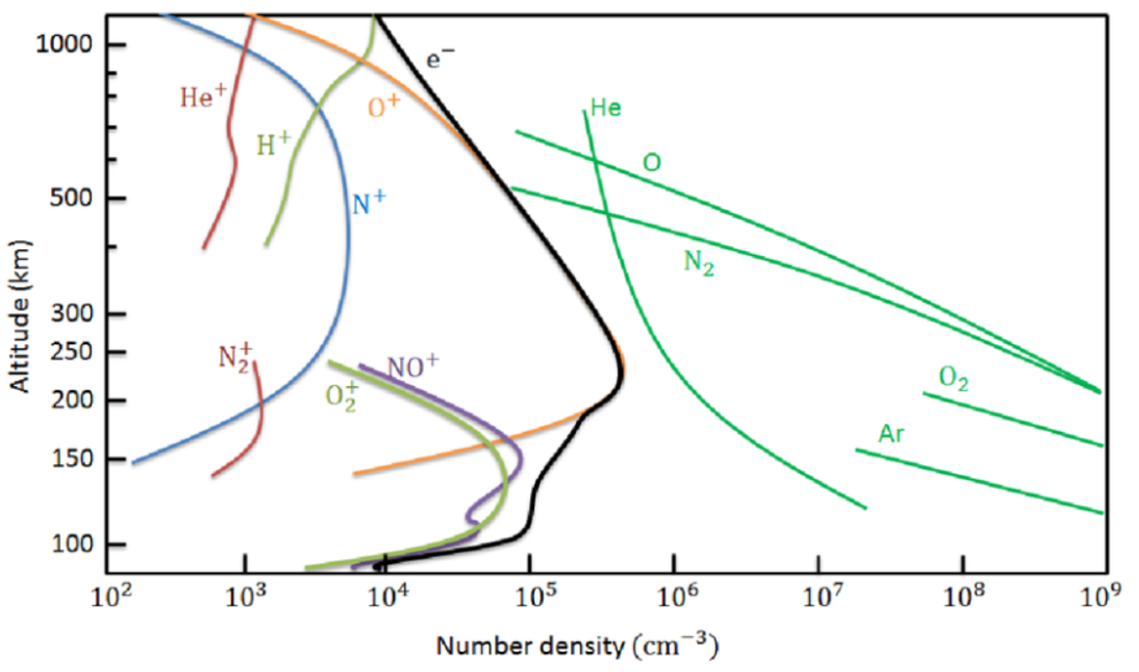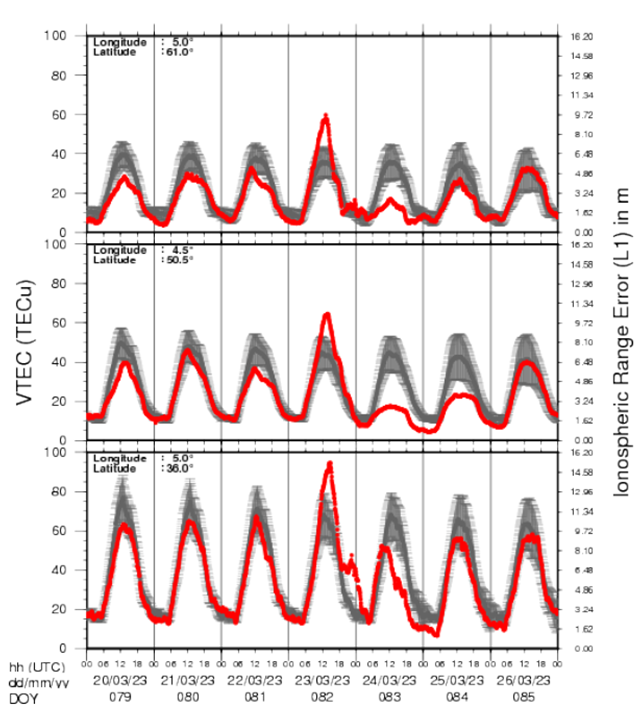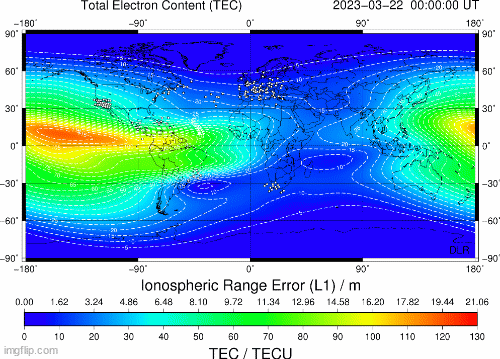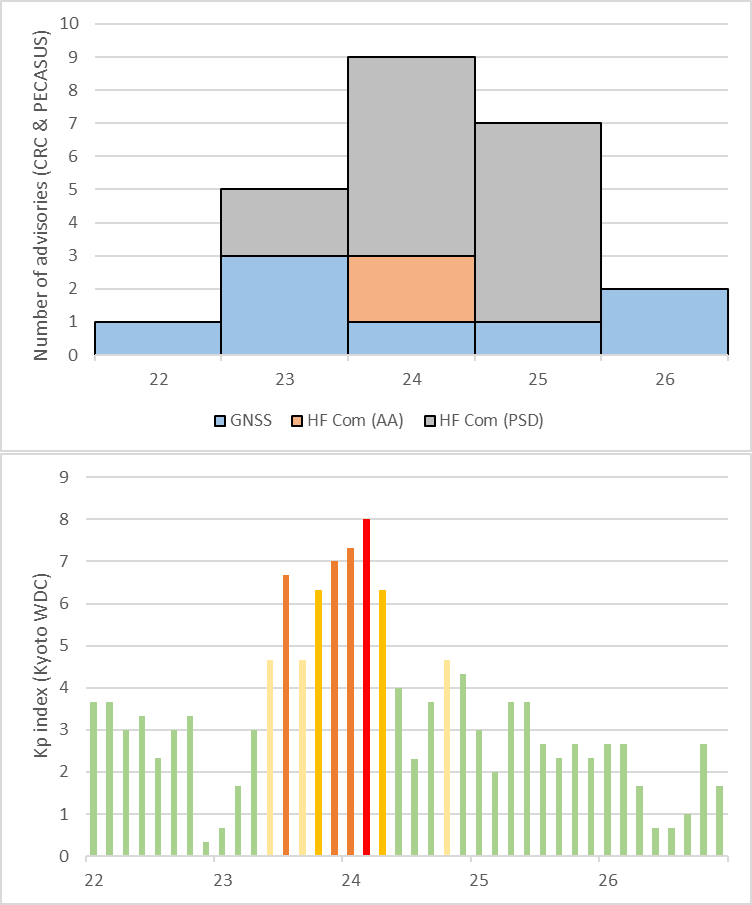The ionosphere is a partially ionized layer of the Earth's upper atmosphere located about 60km to 1000km above the Earth's surface. It consists of a changing concentration of neutral atoms and molecules ("neutrals"), ions and free electrons. Above about 60km the number of these free electrons is sufficient to affect the propagation of electromagnetic waves, e.g. the radio-communication between satellites and the ground-stations. The maximum ionization occurs at altitudes of about 250–400 km ("F-layer"), and is mainly due to solar extreme ultraviolet radiation ionizing atomic oxygen (O) which is the main neutral at that altitude (ROB/GNSS). This can be seen in the graph underneath, with the density of neutrals and ions indicated by respectively the green and other-coloured lines (Akbari 2015; Kelley 1989 - eBook ISBN: 9780323148054 ; Johnson 1969). The electron density is shown by the thick black line, and coincides with the evolution of the density of ionized oxygen (O+ ; orange line). The ionosphere consists mainly of 3 layers (D-, E-, and F-layer), with usually only the F-layer remaining during the night. Since the main cause of ionization in the atmosphere is solar radiation, the behaviour of the quiet ionosphere follows a daily, seasonal and solar cycle pattern. The integrated electron density along the path between the transmitter (satellite) and receiver (ground-station) where the radio waves are propagating, is called the total electron content (TEC), which is measured in TEC units (1 TECU = 1016 electrons per square meter). This newsitem will only consider the vertical TEC (VTEC), which is the TEC directly (perpendicular to the Earth's surface) above the ground-station.

An ionospheric storm is a perturbation of the ionization density at F-region heights. Geomagnetic storms, being the result of a coronal mass ejection or a high-speed solar wind stream passing the Earth, are one of the main sources of ionospheric storms as solar wind energy is captured by the magnetosphere, then transformed and dissipated in the polar upper atmosphere (Prölss 1995 - ISBN-13: 978-1138559028). The evolution of an ionospheric storm is usually based on the evolution of the electron density, as this is the easiest accessible ionospheric parameter. Due to the large variability of the storms and the numerous ongoing processes during such a storm, an ionospheric storm is usually described simply by a positive phase (positive storm) and a negative phase (negative storm), corresponding respectively to a large enhancement and depletion of the maximum electron density compared to the quiet day curve.
A very nice example of the two phases of such an ionospheric storm took place during the severe geomagnetic storm of 23 and 24 March 2023 (see this STCE newsitem). The graph underneath shows the evolution of the VTEC at 3 stations located near the meridian of 5 degrees East: one located in Norway (latitude 61 degrees ; upper graph), one in Brussels (latitude 50.5 degrees ; middle), and one in North-Africa (Algeria, latitude 36 degrees ; lower graph). Each of these 3 graphs shows the local VTEC (red) for the period 20-26 March against the normal ionospheric behaviour expected based on the median VTEC from the 15 previous days (in grey). A positive ionospheric storm can clearly be distinguished in the VTEC evolution on 23 March and a negative storm on 24 March. For Brussels, the negative storm persisted into 25 March. This is a typical behaviour: the disturbed variation in TEC is usually positive in the first 24 hours of the storm. The increase in content may occasionally be very large, with values reached that may be as much as twice that of the undisturbed ionosphere. In the second 24 hours or so the content has decreased below that of the undisturbed ionosphere. The disturbance variation in content has usually disappeared by early in the third storm day, if not earlier (see e.g. the review by Mendillo 2006).

The mechanism behind a negative ionospheric storm is fairly well understood. Geomagnetic activity can lead to atmospheric disturbances changing the neutral composition which in turn can result in a decrease in the ratio between atomic oxygen and molecular nitrogen. This change in neutral composition results in a depletion of the electron content, and thus in a negative ionospheric storm. See Prölss (1995) and Ratovsky et al. (2020) for the details of this mechanism. The mechanisms behind the positive phase of an ionospheric storm constitute an area of active research (see e.g. PITHIA). The main idea is that positive ionospheric storms are caused by upward transport of ionization, where the recombination to neutrals decreases and the electron production increases, leading to an overall increase in the electron density. The main question is how this uplifting happens. An increase in the atomic oxygen density, a change in meridian winds which move the ionosphere to higher altitudes where recombination rates are lower, traveling ionospheric disturbances (TIDs) and disturbed electric fields that cause plasma redistribution are -amongst other- used to explain the nature of positive ionospheric storms (Kassa et al. 2023).
The global ionospheric maps underneath (Credits: DLR/IMPC) provide near real-time information about VTEC derived from ground-based GNSS measurements (GNSS: Global Navigation Satellite System, such as GPS and GALILEO). The clip underneath is at a 1 hour cadence covering the period from 22 to 25 March. This shows the global ionospheric evolution (VTEC) during an undisturbed day (22 March), and the effects from the 23-24 March geomagnetic storm. The positive phase on 23 March can clearly be distinguished in the enhanced VTEC observed that day, and the negative phase (VTEC much lower than during undisturbed days) on 24 and 25 March. This compilation shows the global VTEC maps at a fixed hour (13:00 UTC) highlighting the same phases of the ionospheric storm. The hour was chosen to correspond to the highest VTEC recorded at Brussels.

Credits to DLR who is maintaining the IMPC services. "Ionosphere Monitoring and Prediction Center" (IMPC) is operated by the German Aerospace Center (DLR) at the Neustrelitz location.
The community’s interest in this research field is high because of the significant impact of ionospheric storm effects on the reliable performance of technological systems. Negative ionospheric storm effects (i.e. when VTEC is well below their normal levels) cause serious problems in ground-based HF radio communications, while on the other hand, positive ionospheric storm effects (i.e. when VTEC is well above their normal levels) can cause serious problems such as e.g. ionospheric scintillation effects in satellite communication and navigation (GNSS). On top of that, a set of dependencies (e.g., seasonal, local time, latitudinal, altitude) compile a rather complicated scene for the appearance of ionospheric storm effects, thus keeping the topic a relevant and vivid research field (Tsagouri 2022).
In the case of the 23-24 March geomagnetic storm, a large number of advisories were issued for the benefit of the civil aviation (ICAO). In particular on 24 and 25 March, alerts pertaining to High Frequency (HF) communication problems have been sent. They concerned mostly Post Storm Depressions (PSD), i.e. a decrease of the maximum frequency in HF that can be used (MUF: Maximum Useable Frequency). This is no surprize, as those days coincided with the negative phase of the ionospheric storm, meaning a lower VTEC and thus a weakened F-layer having difficulties to reflect the higher frequencies of the HF radio window (see e.g. Fiori et al. 2022). The upper diagram underneath shows, for the period from 22 until 26 March, the daily number of advisories issued based on CRC and internal PECASUS communications. No distinction has been made for opening, follow-up or closing of advisories, and they are split into GNSS, HF Com AA (Auroral Absorption), and HF Com PSD (Post Storm Depression). The lower diagram underneath shows the evolution of the Kp index (Kyoto WDC) for the same period.






